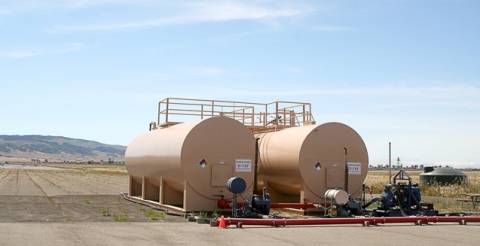SEAT dumps retardant to avoid crash — twice
A single engine air tanker (SEAT) on two occasions in August had to dump part of its retardant load in order to avoid crashing. According to an article in the Missoulian, on August 27 an Air Tractor 802 was attempting to take off from the Ravalli County Airport at Hamilton, Montana (map) when it became evident that it was too heavy to lift off the runway. The pilot released 75 gallons of retardant on the last 75 feet of the runway, which lightened the aircraft enough to allow it to take off. The Hamilton Fire Department rinsed the retardant off the runway.
On August 30 an Air Tractor 802 had cleared the runway but was “in a negative rate of climb”, said Dean Bitterman, forest aviation officer for the Bitterroot National Forest. It was not going to make it over a hill, so pilot Jackie Shadowens released 75 gallons of retardant just north of the runway into grass and wetlands.
The SEAT can hold about 800 gallons of retardant, but had been downloaded by 20% to account for density altitude, which is affected by higher temperatures and altitude.
USFS extends air tanker availability to account for longer fire seasons
This winter for the first time in recent history, the U.S. Forest Service will have a large air tanker on contract through the winter. Butch Weedon reports that Neptune Aviation will have one of their large air tankers, probably a P2V, on contract through the 2011-2012 winter months. In addition, three air tankers will come on earlier next year than usual, on March 1, because the USFS expects the 2012 fire season to start early, as was the case this year.
Neptune still has three air tankers deployed in Texas. One P2V is in Austin and another is at Longview, where their new BAe-146 jet powered air tanker has been stationed for several weeks.
Columbia Helicopters has had one of its twin-rotor Columbia 107 helicopters on extended duty in east Texas, out of Huntsville, since March, under a State contract. Normally that helicopter would end its season in September, but they expect it to remain there until the end of the year, due to the high fire danger.
Other air tankers in Texas
The DC-10 very large air tanker was released from its Texas assignment around October 28, along with three Convair 580 air tankers from Canada.
The Rand air tanker report
The U.S. Forest Service is still not interested in offering exclusive use contracts for very large air tankers (VLAT) that carry 11,600 to 20,000 gallons, which is 6 to 11 times more retardant than the largest “large” air tankers with a capacity of 1,800 to 3,000 gallons. When the Rand Corporation conducted the air tanker study for the USFS, they were instructed by the USFS to not even consider VLATs. Here is a quote from a July, 2010 draft of the 104-page report which has still not been released to the public:
At Forest Service direction, we did not examine smaller SEATs that carry 800-900 gallons of retardant nor larger VLATs that carry 12,000-20,000 gallons of retardant.
Astounding, to say the least. The USFS paid Rand $840,092 for the report.
The draft version of the report recommends 11 to 28 3,000-gallon air tankers, and 14 to 20 2,700-gallon helicopters depending on how they are based, their mobility, and the “prescience” of dispatchers to be able to predict where fires will start. But those are only for initial attack. If the USFS plans to use the aircraft on large fires, they will need more, but the report did not provide a recommendation for that contingency. This year there were 11 large air tankers on exclusive use contracts.
Few people would recommend that air tankers not be used on large fires. And of course they are used routinely and extensively on large fires. For example, on the 6,200-acre Fourmile Canyon fire that burned west of Boulder, Colorado in September, air tankers dropped 86 loads of retardant over a four day period. Below is a map showing the locations of most, but not all, of the retardant drops by large air tankers on that fire. (Click on it to see a larger version.)








